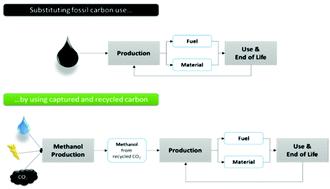当前位置:
X-MOL 学术
›
Green Chem.
›
论文详情
Our official English website, www.x-mol.net, welcomes your feedback! (Note: you will need to create a separate account there.)
Material or fuel: comparative cradle-to-grave climate and material footprint analysis for the use of methanol from recycled CO2
Green Chemistry ( IF 9.8 ) Pub Date : 2020-11-03 , DOI: 10.1039/d0gc02946g Sebastian Turnau 1, 2, 3, 4, 5 , Caroline Sophie Mignot 1, 2, 3, 4, 5 , Clemens Mostert 1, 2, 3, 4, 5 , Stefan Bringezu 1, 2, 3, 4, 5
Green Chemistry ( IF 9.8 ) Pub Date : 2020-11-03 , DOI: 10.1039/d0gc02946g Sebastian Turnau 1, 2, 3, 4, 5 , Caroline Sophie Mignot 1, 2, 3, 4, 5 , Clemens Mostert 1, 2, 3, 4, 5 , Stefan Bringezu 1, 2, 3, 4, 5
Affiliation

|
The European Commission as well as the German government favor an energetic use of methanol from CO2 recycling with their legislation and funding mechanisms. This study uses the product climate footprint and the product material footprint to assess the complete life cycle of fossil-based polypropylene, polyoxymethylene, heavy fuel oil, petrol and diesel compared to a functional equivalent product manufactured with methanol from recycled CO2. Assuming that renewable electricity from wind power feeds the electrolysis for the hydrogen production, the results confirm that the use of recycled CO2 reduces the climate footprint, but increases the material footprint as a trade-off. The substitution of polyoxymethylene provides the highest climate footprint reduction closely followed by the substitution of petrol, followed by polypropylene, heavy fuel oil and diesel. Solely for polyoxymethylene, petrol and heavy fuel oil the greenhouse gas emission savings are relatively higher than the additional material demand. Material recycling and energy substitution from plastics waste incineration provide a benefit to the footprints that is by a factor of three higher than for the substitution of fossil-based polymers alone. The analysis until 2050 reveals that the additional material demand is reduced due to the defossilization of the German electricity grid.
中文翻译:

材料或燃料:比较摇篮到坟墓的气候和材料足迹分析,以使用回收的CO2中的甲醇
欧盟委员会和德国政府通过其立法和资助机制,支持从CO 2循环中大力使用甲醇。这项研究使用产品气候足迹和产品材料足迹来评估化石基聚丙烯,聚甲醛,重质燃料油,汽油和柴油的完整生命周期,而不是使用由回收的CO 2甲醇制造的功能等效产品。假设风力发电产生的可再生电力用于电解制氢,结果证实了使用回收的CO 2减少了气候足迹,但是却增加了材料足迹。聚甲醛的替代可以最大程度地减少气候足迹,其次是汽油,其次是聚丙烯,重质燃料油和柴油。仅用于聚甲醛,汽油和重质燃料油,其温室气体排放节省量相对高于其他材料需求量。塑料垃圾焚烧产生的材料循环利用和能源替代为脚印带来了好处,比仅基于化石的聚合物替代要高三倍。直到2050年的分析表明,由于德国电网的去化石化,减少了额外的材料需求。
更新日期:2020-11-12
中文翻译:

材料或燃料:比较摇篮到坟墓的气候和材料足迹分析,以使用回收的CO2中的甲醇
欧盟委员会和德国政府通过其立法和资助机制,支持从CO 2循环中大力使用甲醇。这项研究使用产品气候足迹和产品材料足迹来评估化石基聚丙烯,聚甲醛,重质燃料油,汽油和柴油的完整生命周期,而不是使用由回收的CO 2甲醇制造的功能等效产品。假设风力发电产生的可再生电力用于电解制氢,结果证实了使用回收的CO 2减少了气候足迹,但是却增加了材料足迹。聚甲醛的替代可以最大程度地减少气候足迹,其次是汽油,其次是聚丙烯,重质燃料油和柴油。仅用于聚甲醛,汽油和重质燃料油,其温室气体排放节省量相对高于其他材料需求量。塑料垃圾焚烧产生的材料循环利用和能源替代为脚印带来了好处,比仅基于化石的聚合物替代要高三倍。直到2050年的分析表明,由于德国电网的去化石化,减少了额外的材料需求。



























 京公网安备 11010802027423号
京公网安备 11010802027423号